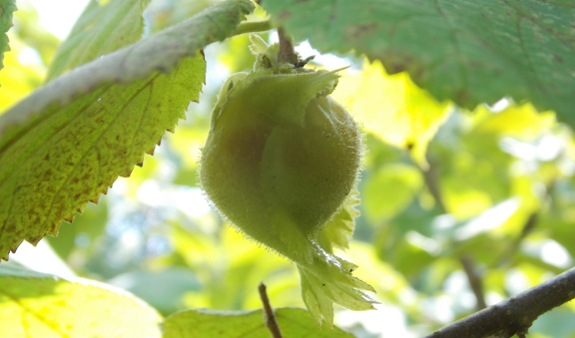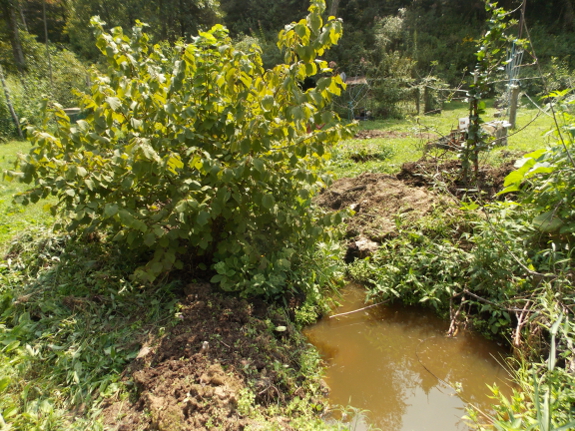
The first hazelnuts

Nuts are notorious for
taking a long time to bear. For most species, you probably
shouldn't expect a harvest for at least a decade, and during that time
nut trees may spread to cover an area fifty feet in diameter. So
it's no surprise that many homesteaders instead turn to the bush growth
habit and relatively fast bearing nature of the hazel.
Of course, "relatively fast" isn't exactly speedy. Almost five years after planting, our unnamed hybrid hazel variety from the Arbor Day Foundation is finally starting to take off, and I was excited to see both male and female flowers on the bush this spring. I'd thought the latter dropped off, but
closer inspection this week turned up a few developing fruits nearly
hidden amid the foliage. Since only one of the three bushes I
originally planted survived, this bush is either self-pollinated or
(more likely) the wild hazels about a hundred feet away in the woods
provided enough pollen for everybody. No matter who the nuts'
daddy is, I'm excited to think that we'll get to taste our first
homegrown hazels this year after all!

Despite our bush's slow
initial growth, it has proven itself able to handle waterlogged soil, as
is evidenced by the "pond" in the photo above, which is actually a pit I dug to gauge groundwater levels and to elevate the surrounding soil.
Unfortunately, the two named varieties I planted in the starplate
pasture this spring have been less resilient in the face of heavy deer
pressure. Only one of the two bushes has survived and I recently
decided that the hazel would probably do better if transplanted into the
safety of our core homestead close to its cousin. In fact, I
might even dig the little survivor up now rather than waiting for the
usual transplanting season (after the leaves fall) since I'm not sure
how much plant will be left after a few more months of deer grazing.
Rambling aside, the purpose of this post is really to tell my father to go check on his hazel bush. Yes, you think
it's never born fruit, but I had to look really, really close to see
the developing nuts on my bush, so yours might have them as well.
Or you can wait a few more weeks until the husks turn brown and look
less like leaves, at which point I suspect the nuts will be more
evident.
Want more in-depth information? Browse through our books.
Or explore more posts by date or by subject.
About us: Anna Hess and Mark Hamilton spent over a decade living self-sufficiently in the mountains of Virginia before moving north to start over from scratch in the foothills of Ohio. They've experimented with permaculture, no-till gardening, trailersteading, home-based microbusinesses and much more, writing about their adventures in both blogs and books.
Want to be notified when new comments are posted on this page? Click on the RSS button after you add a comment to subscribe to the comment feed, or simply check the box beside "email replies to me" while writing your comment.
- Remove comment
